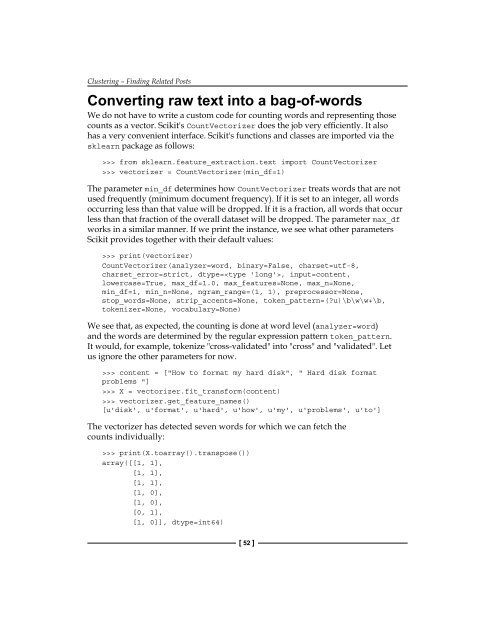1FfUrl0
1FfUrl0
1FfUrl0
Create successful ePaper yourself
Turn your PDF publications into a flip-book with our unique Google optimized e-Paper software.
Clustering – Finding Related Posts<br />
Converting raw text into a bag-of-words<br />
We do not have to write a custom code for counting words and representing those<br />
counts as a vector. Scikit's CountVectorizer does the job very efficiently. It also<br />
has a very convenient interface. Scikit's functions and classes are imported via the<br />
sklearn package as follows:<br />
>>> from sklearn.feature_extraction.text import CountVectorizer<br />
>>> vectorizer = CountVectorizer(min_df=1)<br />
The parameter min_df determines how CountVectorizer treats words that are not<br />
used frequently (minimum document frequency). If it is set to an integer, all words<br />
occurring less than that value will be dropped. If it is a fraction, all words that occur<br />
less than that fraction of the overall dataset will be dropped. The parameter max_df<br />
works in a similar manner. If we print the instance, we see what other parameters<br />
Scikit provides together with their default values:<br />
>>> print(vectorizer)<br />
CountVectorizer(analyzer=word, binary=False, charset=utf-8,<br />
charset_error=strict, dtype=, input=content,<br />
lowercase=True, max_df=1.0, max_features=None, max_n=None,<br />
min_df=1, min_n=None, ngram_range=(1, 1), preprocessor=None,<br />
stop_words=None, strip_accents=None, token_pattern=(?u)\b\w\w+\b,<br />
tokenizer=None, vocabulary=None)<br />
We see that, as expected, the counting is done at word level (analyzer=word)<br />
and the words are determined by the regular expression pattern token_pattern.<br />
It would, for example, tokenize "cross-validated" into "cross" and "validated". Let<br />
us ignore the other parameters for now.<br />
>>> content = ["How to format my hard disk", " Hard disk format<br />
problems "]<br />
>>> X = vectorizer.fit_transform(content)<br />
>>> vectorizer.get_feature_names()<br />
[u'disk', u'format', u'hard', u'how', u'my', u'problems', u'to']<br />
The vectorizer has detected seven words for which we can fetch the<br />
counts individually:<br />
>>> print(X.toarray().transpose())<br />
array([[1, 1],<br />
[1, 1],<br />
[1, 1],<br />
[1, 0],<br />
[1, 0],<br />
[0, 1],<br />
[1, 0]], dtype=int64)<br />
[ 52 ]


